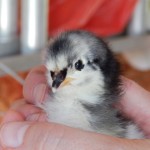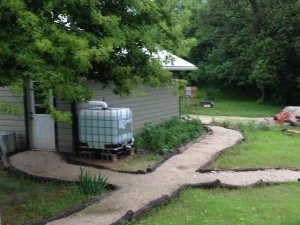East terrace bloomage, and some critters taking advantage.
Chicks Growing Up
We lost one (Florence), but the remaining five continue to thrive.
- Edith
- Frieda
- Helen
- Mildred
- Ruby
First Honey
Six Chicks
Bee Diagnostics
Our bees are challenging us to learn about queen rearing. After a long period of rain, I checked the bees mid-June and found North Hive had created a new hive under the screened bottom board. S came 6/21 to inspect and help right the situation.
The bees had made ten panels of comb under the hive, several containing eggs and brood. S pushed the foundation out of several empty frames, then cut the comb off the bottom board, one panel at a time. She placed the comb in the empty frames and secured the panels with rubber bands.
Removing the bees from the bottom board was difficult because of all the nooks and crannies. Bees were flying everywhere, and we never saw the queen who had been laying eggs. S hoped we had gotten the queen back in the hive, but we couldn’t be sure.
We made a split, which we subsequently took to her place about 15 miles away. This hive E and I brought back on the 26th and installed in our new bee yard on the west.
I checked North Hive a week later on the 28th and found no new eggs, unsealed queen cups on the comb S had moved, and one hinged queen cell. It looks like we lost the original queen from the underneath colony because the bees made emergency queen cells out of the comb S moved. The hinged queen cell suggests that one of the old cells from inside the upper hive hatched. While she was pupating, the bees made new emergency queen cells.
With no babies to care for, the bees are making honey and filling up the brood cells. I think I need to move things around to provide room for the new queen to lay eggs. I’ll ask S what she thinks.
Based on bee development, I should see mating flights from both the North Hive and new West Hive on about July 1. I should see new eggs about a week later on the 8th. I surely hope all will be well.
Queen Diagnostics: A useful document with numerous scenarios and decision trees for remediation.
Cookeville Beekeepers recommends donating a frame of brood to the queenless hive in order to determine if a queen is present. If not, the workers will create queen cells out of the brood.
Thank you, Linda’s Bees, for the link to Beemaster Forum! Finally, I’ve found the fount of wisdom I need to pull off the extraordinarily interesting and challenging work of beekeeping. Linda also suggests a new frame of brood every week for a queenless hive.
Rain Barrels!
Converted IBCs, in fact (see Rain Collection post). Each holds about 250 gallons, and eventually we plan to have six around the house and garage, including a “double” on the northwest corner to feed a vegetable washing station (details pending).
With all the rain we’ve had, they filled up pretty quickly!
Spring Weather
Collards, beets, basil, and so on
South Garden – Late Spring
We’ve come a long way from Spring Work Week, as this gallery shows.
































